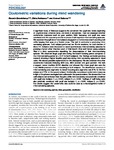Oculometric variations during mind wandering.
| dc.contributor.author | Grandchamp, R | en |
| dc.contributor.author | Braboszcz, C | en |
| dc.contributor.author | Delorme, A | en |
| dc.date.accessioned | 2018-08-13T15:15:43Z | |
| dc.date.available | 2018-08-13T15:15:43Z | |
| dc.date.issued | 2014 | en |
| dc.identifier.issn | 1664-1078 | en |
| dc.identifier.uri | http://hdl.handle.net/10026.1/12120 | |
| dc.description.abstract |
A significant body of literature supports the contention that pupil size varies depending on cognitive load, affective state, and level of drowsiness. Here we assessed whether oculometric measures such as gaze position, blink frequency and pupil size were correlated with the occurrence and time course of self-reported mind-wandering episodes. We recorded the pupil size of two subjects engaged in a monotonous breath counting task while keeping their eyes on a fixation cross. This task is conducive to producing mind-wandering episodes. Each subject performed ten 20-min sessions, for total duration of about 4 h. Subjects were instructed to report spontaneous mind-wandering episodes by pressing a button when they lost count of their breath. After each button press, subjects filled in a short questionnaire describing the characteristics of their mind-wandering episode. We observed larger pupil size during the breath-focusing period compared to the mind-wandering period (p < 0.01 for both subjects). Our findings contradict previous research showing a higher baseline pupil size during mind wandering episodes in visual tasks. We discuss possible explanations for this discrepancy. We also analyzed nine other oculometric measures including blink rate, blink duration and gaze position. We built a support vector machine (SVM) classifier and showed that mean pupil size was the most reliable predictor of mind wandering in both subjects. The classification accuracy of mind wandering data segments vs. breath-focusing data segments was 81% for the first subject and 77% for the second subject. Additionally, we analyzed oculometric measures in light of the phenomenological data collected in the questionnaires. We showed that how well subjects remembered their thoughts while mind wandering was positively correlated with pupil size (subject 1, p < 0.001; subject 2, p < 0.05). Feelings of well being were also positively correlated with pupil size (subject 1, p < 0.001; subject 2, p < 0.001). Our results suggest that oculometric data could be used as a neurocognitive marker of mind-wandering episodes. | en |
| dc.format.extent | 31 - ? | en |
| dc.language | eng | en |
| dc.language.iso | eng | en |
| dc.subject | blinks | en |
| dc.subject | classification | en |
| dc.subject | gaze position | en |
| dc.subject | mind wandering | en |
| dc.subject | pupil size | en |
| dc.title | Oculometric variations during mind wandering. | en |
| dc.type | Journal Article | |
| plymouth.author-url | https://www.ncbi.nlm.nih.gov/pubmed/24575056 | en |
| plymouth.volume | 5 | en |
| plymouth.publication-status | Published online | en |
| plymouth.journal | Front Psychol | en |
| dc.identifier.doi | 10.3389/fpsyg.2014.00031 | en |
| plymouth.organisational-group | /Plymouth | |
| dc.publisher.place | Switzerland | en |
| dcterms.dateAccepted | 2014-01-10 | en |
| dc.rights.embargoperiod | Not known | en |
| rioxxterms.versionofrecord | 10.3389/fpsyg.2014.00031 | en |
| rioxxterms.licenseref.uri | http://www.rioxx.net/licenses/all-rights-reserved | en |
| rioxxterms.licenseref.startdate | 2014 | en |
| rioxxterms.type | Journal Article/Review | en |


